Glasses: Difference between revisions
SMcCandlish (talk | contribs) More sectional cleanup; minor style cleanup; rm. Wozniak stuff per WP:UNDUE and objections on talk page. |
→Sunglasses: source for polarized lenses |
||
| Line 87: | Line 87: | ||
Glasses with [[photosensitive]] lenses, called [[photochromic lens]]es, become darker in the presence of UV light. Unfortunately, many car windshields block the passage of UV light, making photochromic lenses less effective whilst driving on bright days. Still, they offer the convenience of not having to carry both clear glasses and sunglasses to those who frequently go indoors and outdoors during the course of a day. Recent technology has developed specialized photochromic lenses that work behind the windshield of the car, as well as outside of the car. |
Glasses with [[photosensitive]] lenses, called [[photochromic lens]]es, become darker in the presence of UV light. Unfortunately, many car windshields block the passage of UV light, making photochromic lenses less effective whilst driving on bright days. Still, they offer the convenience of not having to carry both clear glasses and sunglasses to those who frequently go indoors and outdoors during the course of a day. Recent technology has developed specialized photochromic lenses that work behind the windshield of the car, as well as outside of the car. |
||
Light [[polarization]] is an added feature that can be applied to sunglass lenses. Polarization filters remove horizontally polarized rays of light, which can cause glare. Popular among fishermen and hunters, polarized sunglasses allow wearers to see into water when normally glare or reflected light would be seen. Polarized sunglasses may present some difficulties for pilots since reflections from water and other structures often used to gauge altitude may be removed, or instrument readings on liquid crystal displays may be blocked. |
Light [[polarization]] is an added feature that can be applied to sunglass lenses. Polarization filters remove horizontally polarized rays of light, which can cause glare. Popular among fishermen and hunters, polarized sunglasses allow wearers to see into water when normally glare or reflected light would be seen.<ref>{{cite web |
||
| title = Sunglasses Glossary |
|||
| publisher = [[SunGlassesUK.com]] |
|||
| url = http://www.sunglassesuk.com/sunglasses_glossary.asp |
|||
| accessdate = 2009-04-23}}</ref> Polarized sunglasses may present some difficulties for pilots since reflections from water and other structures often used to gauge altitude may be removed, or instrument readings on liquid crystal displays may be blocked. |
|||
Yellow lenses are commonly used by golfers and shooters for their contrast enhancement and depth perception properties. Brown lenses are also common among golfers, but cause color distortion. Blue, purple, and green lenses offer no real benefits to vision enhancement and are mainly cosmetic. Some sunglasses with interchangeable lenses have optional clear lenses to protect the eyes during low light or night time activities and a colored lens with UV protection for times where sun protection is needed. Debate exists as to whether "blue blocking" or amber tinted lenses have a protective effect. |
Yellow lenses are commonly used by golfers and shooters for their contrast enhancement and depth perception properties. Brown lenses are also common among golfers, but cause color distortion. Blue, purple, and green lenses offer no real benefits to vision enhancement and are mainly cosmetic. Some sunglasses with interchangeable lenses have optional clear lenses to protect the eyes during low light or night time activities and a colored lens with UV protection for times where sun protection is needed. Debate exists as to whether "blue blocking" or amber tinted lenses have a protective effect. |
||
Revision as of 15:28, 23 April 2009
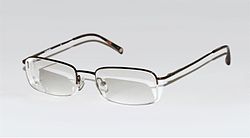
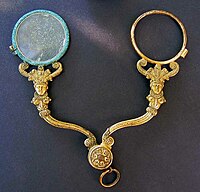
Glasses or specs, more formally known as eyeglasses or spectacles, are frames bearing lenses worn in front of the eyes, normally for vision correction, eye protection, or for protection from UV rays.
Modern glasses are typically supported by pads on the bridge of the nose and by temples placed over the ears. Historical types include the pince-nez, monocle, and lorgnette.
Eyeglass frames are commonly made from metal or plastic. Lenses were originally made from glass, but many are now made from various types of metal plastic, including CR-39 and polycarbonate. These materials reduce the danger of breakage and weigh less than glass lenses. Some plastics also have more advantageous optical properties than glass, such as better transmission of visible light and greater absorption of ultraviolet light.[1] Some plastics have a greater index of refraction than most types of glass; this is useful in the making of corrective lenses shaped to correct various vision abnormalities such as myopia, allowing thinner lenses for a given prescription. Newer plastic lenses, called izon, can also correct for the higher order aberrations that naturally occur in the surface of our eye. These lenses create sharper vision and help with the halos, starbursts, and comet-tails often associated with night time driving glare. Wavefront guided LASIK surgery also corrects for the higher order aberrations.
Scratch-resistant coatings can be applied to most plastic lenses giving them similar scratch resistance to glass. Hydrophobic coatings designed to ease cleaning are also available, as are anti-reflective coatings intended to reduce glare, improve night vision and make the wearer's eyes more visible.[2]
CR-39 lenses are the most common plastic lenses due to their low weight, high scratch resistance, and low transparency for ultra violet and infrared radiation. Polycarbonate and Trivex lenses are the lightest and most shatter-resistant, making them the best for impact protection,[1] yet offer poor optics due to high dispersion, and having a low Abbe number of 31.
Not all glasses are designed solely for vision correction but are worn for protection, viewing visual information (such as stereoscopy) or simply just for aesthetic or fashion values. Safety glasses are a kind of eye protection against flying debris or against visible and near visible light or radiation. Sunglasses allow better vision in bright daylight, and may protect against damage from high levels of ultraviolet light.
History of eyeglasses
Precursors

The earliest historical reference to magnification dates back to ancient Egyptian hieroglyphs in the 8th century BC, which depict "simple glass meniscal lenses". The earliest written record of magnification dates back to the 1st century AD, when Seneca the Younger, a tutor of Emperor Nero, wrote: "Letters, however small and indistinct, are seen enlarged and more clearly through a globe or glass filled with water".[3] Emperor Nero is also said to have watched the gladiatorial games using an emerald as a corrective lens.[4]
Corrective lenses were said to be used by Abbas Ibn Firnas in the 9th century,[5] who had devised a way to produce very clear glass. These glasses could be shaped and polished into round rocks used for viewing and were known as reading stones. The earliest evidence of "a magnifying device, a convex lens forming a magnified image," dates back the Book of Optics published by Alhazen in 1021. Its translation into Latin in the 12th century was instrumental to the invention of eyeglasses in 13th century Italy.[3]
Sunglasses, in the form of flat panes of smoky quartz, protected the eyes from glare and were used in China in the 12th century or possibly earlier. However, they did not offer any corrective powers.[6]
Invention of eyeglasses
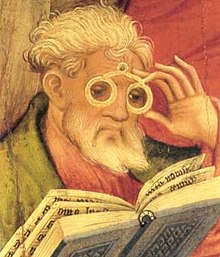
Around 1284 in Italy, Salvino D'Armate is credited with inventing the first wearable eye glasses.[7] The earliest pictorial evidence for the use of eyeglasses, however, is Tomaso da Modena's 1352 portrait of the cardinal Hugh de Provence reading in a scriptorium. Another early example would be a depiction of eyeglasses found north of the Alpes in an altarpiece of the church of Bad Wildungen, Germany, in 1403.
Many theories abound for who should be credited for the invention of traditional eyeglasses. In 1676, Francesco Redi, a professor of medicine at the University of Pisa, wrote that he possessed a 1289 manuscript whose author complains that he would be unable to read or write were it not for the recent invention of glasses. He also produced a record of a sermon given in 1305, in which the speaker, a Dominican monk named Fra Giordano da Rivalto, remarked that glasses had been invented less than twenty years previously, and that he had met the inventor. Based on this evidence, Redi credited another Dominican monk, Fra Alessandro da Spina of Pisa, with the re-invention of glasses after their original inventor kept them a secret, a claim contained in da Spina's obituary record.[8]

Other stories, possibly legendary, credit Roger Bacon with the invention. Bacon is known to have made one of the first recorded references to the magnifying properties of lenses in 1262,[9] though this was predated by Alhazen's Book of Optics in 1021.[3] Bacon's treatise De iride ("On the Rainbow"), which was written while he was a student of Robert Grosseteste, no later than 1235, mentions using optics to "read the smallest letters at incredible distances". While the exact date and inventor may be forever disputed, it is almost certain that spectacles were invented between 1280 and 1300 in Italy. These early spectacles had convex lenses that could correct both hyperopia (farsightedness), and the presbyopia that commonly develops as a symptom of aging. Nicholas of Cusa is believed to have discovered the benefits of concave lens in the treatment of myopia (nearsightedness). However, it was not until 1604 that Johannes Kepler published in his treatise on optics and astronomy, the first correct explanation as to why convex and concave lenses could correct presbyopia and myopia.
Later developments

The American scientist Benjamin Franklin, who suffered from both myopia and presbyopia, invented bifocals in 1784 to avoid having to regularly switch between two pairs of glasses.[10] The first lenses for correcting astigmatism were constructed by the British astronomer George Airy in 1825.[10]
Over time, the construction of spectacle frames also evolved. Early eyepieces were designed to be either held in place by hand or by exerting pressure on the nose (pince-nez). Girolamo Savonarola suggested that eyepieces could be held in place by a ribbon passed over the wearer's head, this in turn secured by the weight of a hat. The modern style of glasses, held by temples passing over the ears, was developed in 1727 by the British optician Edward Scarlett. These designs were not immediately successful, however, and various styles with attached handles such as "scissors-glasses" and lorgnettes remained fashionable throughout the 18th and into the early 19th century.
In the early 20th century, Moritz von Rohr at Zeiss (with the assistance of H. Boegehold and A. Sonnefeld[11]), developed the Zeiss Punktal spherical point-focus lenses that dominated the eyeglass lens field for many years.
Despite the increasing popularity of contact lenses and laser corrective eye surgery, glasses remain very common, as their technology has improved. For instance, it is now possible to purchase frames made of special memory metal alloys that return to their correct shape after being bent. Other frames have spring-loaded hinges. Either of these designs offers dramatically better ability to withstand the stresses of daily wear and the occasional accident. Modern frames are also often made from strong, light-weight materials such as titanium alloys, which were not available in earlier times.
Types
Corrective
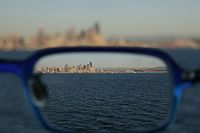
Corrective lenses modify the focal length of the eye to alleviate the effects of nearsightedness (myopia), farsightedness (hyperopia) or astigmatism. As people age, the eye's crystalline lens loses elasticity, resulting in presbyopia, which limits their ability to change focus.
The power of a lens is generally measured in diopters. Over-the-counter reading glasses are typically rated at +1.00 to +4.00 diopters. Glasses correcting for myopia will have negative diopter strengths. Lenses made to conform to the prescription of an ophthalmologist or optometrist are called prescription lenses and are used to make prescription glasses, which are then verified correct using a professional lensmeter.
Safety
Safety glasses are usually made with shatter-resistant plastic lenses to protect the eye from flying debris. Although safety lenses may be constructed from a variety of materials of various impact resistance, certain standards suggest that they maintain a minimum 1 millimeter thickness at the thinnest point, regardless of material. Safety glasses can vary in the level of protection they provide. For example, those used in medicine may be expected to protect against blood splatter while safety glasses in a factory might have stronger lenses and a stronger frame with additional shields at the temples. The lenses of safety glasses can also be shaped for correction.
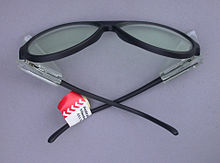
The American National Standards Institute has established standard ANSI Z87.1 for safety glasses in the United States, and similar standards have been established elsewhere.
OSHA provides guidance on the type of safety eyewear that should be used for a particular application.
Some safety glasses are designed to fit over corrective glasses or sunglasses. They may provide less eye protection than goggles or other forms of eye protection, but their light weight increases the likelihood that they will actually be used. Modern safety glasses tend to be given a more stylish design in order to encourage their use. Corrective glasses with plastic lenses can be used in the place of safety glasses in many environments; this is one advantage that they have over contact lenses.
There are also safety glasses for welding, which are styled like wraparound sunglasses, but with much darker lenses, for use in welding where a full sized welding helmet is inconvenient or uncomfortable. These are often called "flash goggles", because they provide protection from welding flash.
Worker safety eyewear is available in various lens colors and/or with coatings to protect or enable eyesight in different lighting conditions, particularly when outdoors.
Nylon frames are usually used for protection eyewear for sports because of their lightweight and flexible properties. They are able to bend slightly and return to their original shape instead of breaking when pressure is applied to them. Nylon frames can become very brittle with age and they can be difficult to adjust.
Sunglasses
Sunglasses may be made with either prescription or non-prescription lenses that are darkened to provide protection against bright visible and possibly ultraviolet light.
Glasses with photosensitive lenses, called photochromic lenses, become darker in the presence of UV light. Unfortunately, many car windshields block the passage of UV light, making photochromic lenses less effective whilst driving on bright days. Still, they offer the convenience of not having to carry both clear glasses and sunglasses to those who frequently go indoors and outdoors during the course of a day. Recent technology has developed specialized photochromic lenses that work behind the windshield of the car, as well as outside of the car.
Light polarization is an added feature that can be applied to sunglass lenses. Polarization filters remove horizontally polarized rays of light, which can cause glare. Popular among fishermen and hunters, polarized sunglasses allow wearers to see into water when normally glare or reflected light would be seen.[12] Polarized sunglasses may present some difficulties for pilots since reflections from water and other structures often used to gauge altitude may be removed, or instrument readings on liquid crystal displays may be blocked.
Yellow lenses are commonly used by golfers and shooters for their contrast enhancement and depth perception properties. Brown lenses are also common among golfers, but cause color distortion. Blue, purple, and green lenses offer no real benefits to vision enhancement and are mainly cosmetic. Some sunglasses with interchangeable lenses have optional clear lenses to protect the eyes during low light or night time activities and a colored lens with UV protection for times where sun protection is needed. Debate exists as to whether "blue blocking" or amber tinted lenses have a protective effect.
Sunglasses are often worn just for aesthetic purposes, or simply to hide the eyes. Examples of sunglasses that were popular for these reasons include teashades and mirrorshades.
3D Glasses
The illusion of three dimensions on a two dimensional surface can be created by providing each eye with different visual information. Classic 3D glasses create the illusion of three dimensions when viewing specially prepared images. The classic 3D glasses have one red lens and one blue lens. 3D glasses made of cardboard and plastic are distributed at 3D movies. Another kind of 3D glasses uses polarized filters, with one lens polarized vertically and the other horizontally, with the two images required for stereo vision polarized the same way. Polarized 3D glasses allow for color 3D, while the red-blue lenses produce a dull black-and-white picture with red and blue fringes.
One kind of electronic 3D spectacles uses electronic shutters, while virtual reality glasses and helmets have separate video screens for each eye. A 3D effect can also be produced using LCD shutter glasses[13]
Reading glasses
Magnifying lenses which are used to treat mild hyperopia and presbyopia, normally referred to as reading glasses, can be bought off the shelf. Most glasses are made to an individual prescription, based on degree of myopia or hyperopia combined with astigmatism if applicable. Lenses can be ground to specific prescriptions, but in some cases standard off-the-shelf prescriptions suffice, though they require custom fitting to particular frames.
Bifocals, trifocals and progressive lenses
As people age, their ability to focus is lessened and many decide to use multiple-focus lenses, bifocal or even trifocal to cover all the situations in which they use their sight. Traditional multifocal lenses have two or three distinct horizontal viewing areas, each requiring a conscious effort of refocusing. Some modern multifocal lenses, such as progressive lenses (known as "no-line bifocals"), give a smooth transition between these different focal points, unnoticeable by most wearers, while other glasses have lenses specifically intended for use with computer monitors at a fixed distance. People may have several pairs of glasses, one for each task or distance, with specific glasses for reading, computer use, television watching, and writing.
Extreme magnification (bioptics)
A form of glasses with extreme magnification to improve the distance vision of those with severe eyesight impairment, especially people with albinism, are known as bioptics or a bioptic telescope. They may take the form of self-contained glasses that resemble goggles or binoculars, or may be attached to existing glasses.
Fashion

Glasses can be a major part of personal image and expression, from Groucho Marx and Buddy Holly to the extravagance of Elton John and Dame Edna Everage.
For some celebrities, glasses form part of their identity. United States Senator Barry Goldwater continued to wear lensless horn-rimmed spectacles after being fitted with contact lenses because he was not recognizable without his trademark glasses. British soap star Anne Kirkbride had the same problem: her character on Coronation Street, Deirdre Barlow, became so well-known for her big frames that she was expected to wear them at social gatherings and in international tours, even though Kirkbride has always worn contact lenses. Comedian Drew Carey continued to wear glasses for the same reason after getting corrective laser eye surgery. British comedic actor Eric Sykes, who became profoundly deaf as an adult, wears glasses that contain no lenses; they are actually a bone-conducting hearing aid. Masaharu Morimoto wears glasses to separate his professional persona as a chef from his stage persona as Iron Chef Japanese. John Lennon wore his round-lens 'Windsor' spectacles from some of his time with the Beatles to his murder in 1980. The rock band Weezer is known for some of the members wearing thick-rimmed glasses.
In popular culture, glasses were all the disguise Superman and Wonder Woman needed to hide in plain view as alter egos Clark Kent and Diana Prince, respectively. An example of halo effect is seen in the stereotype that those who wear glasses are intelligent or, especially in teen culture, even geeks and nerds. Some people who find that wearing glasses may look 'nerdy' turn to contact lenses or laser eye surgery, especially under peer pressure.
Another unpopular aspect of glasses is their inconvenience. Even through the creation of light frames, such as those made of titanium, very flexible frames, and new lens materials and optical coatings, glasses can still cause problems during rigorous sports. The lenses can become greasy or trap vapour when eating hot food, swimming, walking in rain or rapid temperature changes (such as walking into a warm building from cold temperatures outside), reducing visibility significantly. Scraping, fracturing, or breakage of the lenses require time-consuming and costly professional repair, though modern plastic lenses are almost indestructible and very scratch-resistant.
Rimless style
Three-piece rimless and semi-rimless glasses are common variations that differ from regular glasses in that their frames do not completely encircle the lenses. Three-piece rimless glasses have no frame around the lenses, and the bridge and temples are mounted directly onto the lenses. Semi-rimless (or half-rimless) glasses have a frame that only partially encircles the lenses (commonly the top portion). When the style was first introduced in the 1930s, lenses were screwed directly to the front of the frame; most modern variations feature the lenses held inside of the frame by high strength nylon wire,[14] although the semi-rimless style has been around since at least the 1940s. A rare and currently noncommercial variation are rimless and frameless glasses attached to a piercing at the bridge of a wearers nose.[15] Such glasses have the visual look of the pince-nez.
Glazing
Spectacle lenses are edged into the frame's rim using glazing machines operated by ophthalmic technicians. The edging process begins with a trace being taken of the frame's eye shape. In earlier days the trace was replicated onto a plastic pattern called a former. Nowadays the process is patternless and the shape is sent to the edger electronically.
The lens, in the form of a round uncut,[clarification needed] is positioned in the correct manner to match the prescription and a block is stuck to the lens and that block fits into a chuck in the edging machine. A diamond-coated wheel spins as the edger replicates the frame's eye-shape to the uncut lens. A V-shaped bevel is applied to allow the edge of the lens to fit into the frame rim.
Redistribution
Some organizations like Lions Clubs International[16] and Unite For Sight[17] provide a way to donate glasses and sunglasses. Unite For Sight has redistributed more than 200,000 pairs.[18]
See also
- Eye examination
- Eyeglass prescription
- Corrective lens
- Geek chic
- History of optics
- Meganekko
- Sunglasses
- X-ray vision
- Stereoscopy
References
- ^ a b DeFranco, Liz (2007). "Polycarbonate Lenses: Tough as Nails". All About Vision. Retrieved 2007-09-01.
{{cite web}}: Unknown parameter|month=ignored (help) - ^ DeFranco, Liz (2006). "Do You Need Lens Coatings?". All About Vision. Retrieved 2007-09-01.
{{cite web}}: Unknown parameter|month=ignored (help) - ^ a b c Kriss, Timothy C.; Kriss, Vesna Martich (April 1998), "History of the Operating Microscope: From Magnifying Glass to Microneurosurgery", Neurosurgery, 42 (4): 899–907, doi:10.1097/00006123-199804000-00116
- ^ Pliny the Elder. "Natural History". Retrieved 2008-04-27.
- ^ Dr. Kasem Ajram (1992). Miracle of Islamic Science, Appendix B. Knowledge House Publishers. ISBN 0911119434.
- ^ Ament, Phil (2006-12-04). "Sunglasses History - The Invention of Sunglasses". The Great Idea Finder. Vaunt Design Group. Retrieved 2007-06-28.
- ^ Bellis, Mary. "The History of Eye Glasses or Spectacles". About.com:Inventors. Retrieved 2007-09-01.
- ^ "Famous Historical Statements up to 1600". Antique Spectacles. Retrieved 2007-09-01.
- ^ "....Optics Highlights: II. Spectacles". University of Maryland, Department of Electrical & Computer Engineering. Retrieved 2007-09-01.
- ^ a b Bellis, Mary. "The Inventions and Scientific Achievements of Benjamin Franklin". Retrieved 2007-09-01.
- ^ "Eyeglass Lenses and Visual Aids from Industrial Production". Zeiss.com. Retrieved 2007-09-02.
- ^ "Sunglasses Glossary". SunGlassesUK.com. Retrieved 2009-04-23.
- ^ "Technologies for Consumer 3D Anatomical Interactivity". OCB Media. 1st October 2008. Retrieved 2009-01-26.
{{cite web}}: Check date values in:|date=(help) - ^ O'Keefe, Jackie (July/August 2003). "The Newest Technologies in Rimless Eyewear". Vision Care Product News. Retrieved 2006-01-09.
{{cite web}}: Check date values in:|date=(help); Italic or bold markup not allowed in:|publisher=(help) - ^ "Pierced Glasses". Retrieved 2007-08-07.
- ^ Lions Clubs International. "Lions Eyeglasses Recycling Facts " received 20 August 2008.
- ^ Unite For Sight "Donate Eyeglasses and Sunglasses" received on 20 August 2008.
- ^ "2007 BRICK Award Winner: Jennifer Staple" HowStuffWorks 20 February 2007, received 20 August 2008.
External links
- Glasses Advisor, topics on eyeglasses, especially prescription glasses.
- Antique Spectacles, extensive history and pictures of spectacles.
- British Optical Association Museum, Spectacles Gallery
- History of Eye Glasses, Teagle Optometry
